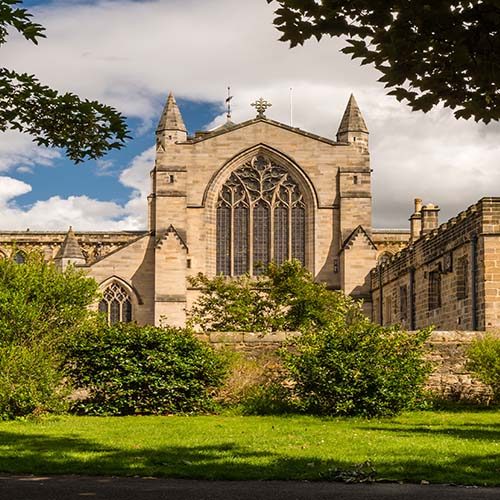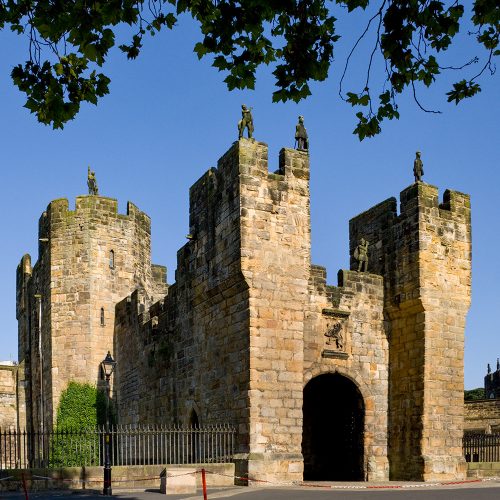
EXPLORE

Beaufront is a perfect place from which to explore Northumberland and rural County Durham. We are also less than 30 minutes from bustling Newcastle, which can be reached by surprisingly frequent buses and trains, as well as by car. This is true Border Country and there are 7 castles within 6 miles of our front door. Two gastropubs are within 3 miles , some outstanding restaurants are within an easy drive ( 2 with Michelin stars) , and we have one of the best bits of Hadrian’s Wall just up the lane. Some of the stone in at Beaufront was ‘borrowed’ from Hadrian’s Wall and you can spot it by its high quality dressing and standardised dimensions.
Two world class golf courses at Slaley and Matfen are within a short drive. To the immediate North is the wilderness of Kielder, famous these days for its dark skies and being the stargazing centre for England, as well as for its abundant wildlife and endless emptiness. But when you look south from your private garden and bedroom windows at Beaufront, you are looking at 350 square miles of rolling countryside, with tiers of hills stretching way into the distance . There are rewarding circular walks from the property, starting with a gentle stroll down the hill to the meadow where some of our English Longhorn cattle live, and grading to all day hikes .
Beamish Museum , voted the best open air museum in the world, which attracted 750,000 visitors last year, is 40 minutes away, as is magnificent Durham Cathedral. A day trip to Lake District is easy. We allow 75 minutes to get to Ullswater.
Hexham

Historic Hexham punches above its weight and serves a very large catchment area. That means that it has 7 supermarkets, including Waitrose and Marks & Spencer. Its star attraction is Hexham Abbey, which, when it was first built in the 7th century, was the largest church north of the Alps . The crypt, which re-uses carved Roman stones , survives, and is open for visitors. The choir sings beautifully and there are frequent services, recitals and concerts . The annual Hexham Book Festival is fantastic.
Next to the Abbey, Hexham has a farmers’ market every other Saturday, and good market stalls on every Tuesday , including an excellent fish and game seller. Hexham has free parking almost everywhere and the parking discs you need for some streets are available in several outlets in the town .
corbridge

Corbridge was once the county town of Northumberland until it fell asleep in about 1800. It awoke once the by-pass was built in 1990, and is now a tranquil paradise for shoppers and people with an interest in history. The Church has a Saxon tower re-using stones taken from the nearby Roman town of Corstopitum. The bridge is famous for being the only bridge across the Tyne to survive the great flood of 1771. And on the south bank of the river, about 400 yards west of the southern end of the present bridge, you will find all the massive stones that once used to form the Roman bridge .
Near Corbridge is Aydon Castle – a perfectly preserved mediaeval castle still with its roof on. In February the snowdrops that carpet the very steep valley immediately below the castle are memorable .
Corbridge church hosts a chamber music festival every Summer and the standard is very high .
Wallington Hall and Cragside

We got married at Wallington Hall on a sunny July day where typically for Northumberland we were just about the only visitors. The hall and its vast estate were given to the National Trust in the Trust’s early days and it is a fascinating place with a good cafe . But the main reason to go is to see the walled garden. It is a magical place and to get there you head down through a leafy beechwood , past a lake dotted with lilies, then open a creaky door in a wall and there you are.It seems to go on for ever and you would never guess that you were on the same latitude as Leningrad !
After Wallington keen gardeners should visit nearby Harterton, where a couple in their late 80’s sell rare plants that can cope with the climate in the far north. And then head on to Rothbury and Cragside – another fantastic National Trust property famous for being the first house lit by electricity in the world. The pioneering engineering installations have recently been restored . In June it has a glorious display of hundreds of acres of rhododendrons. After Cragside perhaps take in nearby Brinkburn Priory, the most hidden away church in the county nestled nearly a mile from the main road on the banks of the River Coquet. The Fenwick family restored it and re-roofed it in the mid 19th century and so it is a rare example of an abandoned religious building that isn’t a ruin, an d all the more magical for that . A perfect picnic spot.
The Puffins and the Northumberland Coast

The Northumberland coast is rightly famous . There are miles and miles of sandy beaches , several castles and of course the famous Farne Islands, home to countless puffins and grey seals at certain times of the year. Choose a calm day , look on line for times for boat trips, and away you go .
Our favourite spot is Low Newton – a village built on three sides of a central square – and the 4th side is the North Sea crashing towards you over a rocky spit on which seals call as the sun sets. And most agreeably , this gem of a place has a good pub that serves locally sourced food . Another fine place is Alnmouth, which has good walks , pubs and a golf course right on the shore .
There’s a long distance coastal path, and for much of its length it hugs the shore. Memorable walks along it can happen every week of the year.
Also near the coast are Warkworth with its magnificent castle and good tea rooms, and Chillingham,where the rarest cattle in the world -just over 100 in number- have grazed the same emparked fields for over 800 years without ever cross breeding , and they are now considered a subspecies in their own right. Chillingham church is worth a quick look too ; it bristles with monuments , as is the castle, if you are lucky enough to find it open.
Alnwick Castle and Howick Hall

Alnwick castle was quite well known, and then the filming of Harry Potter there gave it a tremendous lift . The increased visitor traffic means that all is shiny bright, and there are more famous works of art inside it than anyone might guess. As a town, Alnwick has had a real boost and that is reflected wherever you go . Even the branch line to it is being re-opened. The best restaurant of all is the tree house restaurant at the Alnwick Garden, the brainchild of the present Duchess of Northumberland. Her vision is now well grown and the place feels very well established.
Near to Alnwick is the sometimes overlooked Howick Hall, home to the family of which Earl Grey ( yes, he of the tea and the monument ) is the most famous scion. The grounds are a showcase for interesting and rare trees and the long stream-side walk there is magical. It leads down to the sea and brings you out near Howick Haven – horseshoe formed rocks with countless rock pools for children to explore. Lunch or afternoon tea at Howick is really rather good and very home made, and the dining chairs are particularly comfortable .
We generally drive to Alnwick via pretty Rothbury and the empty roads of rural Northumberland. You will see the unheard of Simonside Hills en route – also worth a walk from the scenic and lonely Fontburn reservoir.
Bamburgh Castle and Holy Island

Bamburgh Castle dominates the seaside village of Bamburgh and looks at its best from about 800 yards distance – which is just as well because you cannot visit the inside. It was the Winter seat of the ancient kings of Northumbria who reigned 600 to 900 AD. Their Summer seat was a massive wooden palace on a hilltop at Yeavering Bell 20 miles to the west, and well worth exploring too . The hilltop is still there and easy to climb, but the wooden structures were repeatedly burnt down by the raiding Danes. If you are clever you can plot ( and walk) the route on existing footpaths that the royal train of ox carts laden with the court would have taken every Spring as the court moved west from Bamburgh.
Across the sea from Bamburgh is Holy Island or Lindisfarne, at one time home to the greatest and most influential religious learning in Europe . Make sure you look online at the tide tables before planning a trip there. But if you can spot a time on an afternoon when the tidal causeway reopens you will be sure of a visit with almost no-one else there . The castle ( restored by Lutyens) is magnificent, as is the ruined church .








